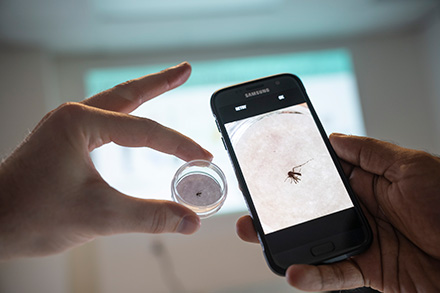USF researchers are working on novel solutions to fight the spread of deadly mosquito-borne diseases worldwide. One way to combat these pests includes a new global dashboard that uses data from smartphone users and other worldwide invasive mosquito research.
The Global Mosquito Observations Dashboard is part of a large-scale project to establish global surveillance of mosquito-borne diseases with automated mosquito identification. It is funded by a four-year grant from the National Science Foundation.
Invasive mosquito dashboard
The dashboard combines data from three partner apps – Mosquito Alert, NASA’s GLOBE Observer and iNaturalist. Each app uses citizen science, where everyday people around the world provide photos of mosquitoes using their smartphones.
For Florida residents, mosquitoes are a known nuisance. Over a dozen species native to the area are carriers of disease. Each year, mosquitoes cause nearly 700 million infections and more than one million deaths. This makes mosquitoes the deadliest animal on Earth. Only a small percentage of the mosquito species transmit diseases. Therefore, extensive surveillance and precise identification are critical in community defense.
Related: USF Student Creates Lumber Alternative from Recycled Plastic
With the combined international data from research centers and citizens, the dashboard has the potential to provide data at a frequency and geographic resolution otherwise impossible because of cost and other constraints. The dashboard is accessible via computer browser or mobile device.
“This dashboard represents a unification of global citizen science platforms for mosquito surveillance and control,” said principal investigator Ryan Carney, assistant professor of integrative biology. “This tool will help mosquito control personnel to seek and destroy invasive species and monitor disease vectors on an international basis by leveraging the geo-reference computers people carry around in their pockets every day: their smartphones.”
Testing the dashboard
To test the effectiveness of citizen science for the surveillance of mosquitoes, Carney and a team of three USF students asked citizen scientists to target primary vectors of Zika, yellow fever, dengue and Chikungunya. The citizen scientists succeed in locating vectors. And their efforts resulted in the first iNaturalist observations in the U.S. of Aedes scapularis. This is an invasive species that causes yellow fever. The documentation was shared with local vector control officials in Texas. This also serves as a model for monitoring in Florida, where the species recently invaded.

The study was recently published in a special edition of the journal Insects. It will serve as a reference for future planning and execution of citizen science projects.
This project is also in collaboration with the Wilson Center’s Science and Technology Innovation Program, the Institute for Global Environmental Strategies and NASA Earth Science Education Collaborative and the U.S. Department of State.




























